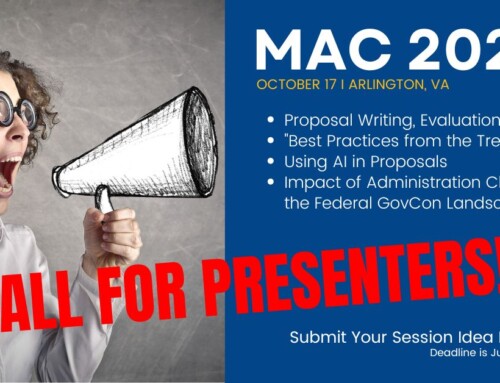In the early 19th Century, Scottish lawyer-turned-geologist Sir Charles Lyell argued, “The present is the key to the past, and the past is the key to the future.” In other words, if we want to know what’s going to happen in the future, we look to the past, to its patterns.
A more contemporary source, the popular movie Back to the Future, featured an infamous Sports Almanac, which was a collection of present statistics brought to the past and used by Biff to cheat on sports bets. Although Marty McFly and Doctor Emmett Brown agreed this “demonstrates precisely how time travel can be misused,” what if they were able to use that knowledge for good? By extrapolating the patterns they see, they could gain an insight into the future.
Here are 3 workforce patterns Marty McFly and Doctor Emmett Brown might have recognized when they went back to the future and what they help us predict about the future of capture and proposal management.[intense_blockquote width=”33%” rightalign=”1″]Organizations that provide instant access to content will achieve better quality proposals written faster with more time to review and improve.[/intense_blockquote]
#1 Communicating vs Collaborating
Communication is the key to understanding between people. From cave paintings and smoke signals to carrier pigeons, telephone and email, the technology that drives our communication has certainly evolved through the years. For example, in the past, Marty and Doc would have used the typing pool and paper copies to communicate their proposal tasks and deadlines. Back to the future, and the rise of computers and the Internet, meant they no longer had to wait to share information. They could communicate their review copies in just a matter of seconds.
As much of a “killer app” as email is, it doesn’t allow for the immediate, or efficient, exchange of ideas that today’s digital proposal workforce demands. For example, if Marty sends out a review copy to Doc, Biff, and Lorraine, they will all return their own marked-up version, complete with their own, often conflicting, comments and ideas on revisions. Lost is the exchange of ideas, or “mind-share” necessary to collaborate on the winning work-product and avoid the never-ending revision cycle.
The internet, personal computer, and email revolutionized the way we work proposals, making how we communicate as a team a lot less time-consuming and frustrating. Now enter Social Media, which has created a greater sense of urgency of anytime/anywhere communication and a greater demand for the instant writing and reviewing feedback loop email cannot deliver.

Prediction: Proposals are a team sport, and a quality feedback loop between players will better position your team for the win. In other words, if you give Marty, Doc, and Lorraine a way to build off of their differing review perspectives, to share their comments, and to come to consensus on their feedback real-time, they will achieve more productive review cycles and avoid endless revisions.
#2 Office Culture and Remote Work
Back in the day, if Marty and Doc had visited a typical business office, they might have seen typing pools, vast rooms of rows and rows of identical desks crammed together factory-style, and corner offices, which were meant to convey hierarchical status. Work and productivity were managed by keeping workers visible. Everyone was smoking right there in the office, and the three-martini lunch was an accepted part of company work culture!
But just as typing pools and paper copies got the boot with the advent of faster, connected computers, strict work structures went by the wayside for the benefits of teamwork. Back to the future and Marty and Doc would have seen a revolution in both how we work, and where we work. Instead of rigid, factory-like, task driven structures, we are all in now – everyone contributing from wherever they are on whatever they can help with. Collaboration is king in the modern, on-the-go office environment.
The Internet, personal computer, and email have done more than just revolutionize how we work on proposals, but also the where we work on proposals. Today’s proposal professionals are digital natives— they have grown up using the Internet, Social Media, and Smart phones, and fully expect to harness the latest and greatest technology to be successful. Not only do they want to work remotely, they expect to have the right to work remotely. In fact, according to The Conference Board, every year since 2005, the share of full-time employees working from home has increased.[intense_blockquote width=”33%” rightalign=”1″]Proposals are a team sport, and a quality feedback loop between players will better position your team for the win.[/intense_blockquote]
With computers, Marty and Doc no longer have to be in the same office or “war room.” They can share documents they are writing via email and shared folders and online repositories. Enter content collaboration platforms, and they can work together anytime, anywhere, create tighter team bonds, and help organizations to harness the corporate “mind-share” necessary for developing winning proposals.

Prediction: Remote work will continue to trend up as a younger, more “mobile” workforce, discovers the capture and proposal management career path. Companies who embrace a remote work culture will attract quality candidates. Companies who deliver the collaborative technology they need to be successful will harness their collaborative energy and grow. Organizations that do not encourage this modern approach will inevitably fall behind.
#3 Paper Binders and Content Libraries
If you’re old enough to remember typing up a proposal on an IBM Selectric, then you know the challenge of reusing proposal content. Back in the day, Marty and Doc would have shipped a box full of binders with answers to RFP questions – and then stored a set for themselves for posterity. When it was time to work on the next proposal they faced two options: the frustrating “blank page” or the frustration of rifling through a paper binder for what they wrote before.
 Back to the future and content management has evolved exponentially due to advanced technology. Not only can Marty and Doc centralize and store their proposal content electronically (document management), they can capture writing, reviewing, and revising automatically (content collaboration) for on-demand use. They can easily search for everything from answers to questions, resumes, and past performances to comprehensive overviews for reuse. By establishing this framework, Marty and Doc provide 24-hour access to information and the team “mind share,” eliminating missed emails, wrong documents, and lost details.
Back to the future and content management has evolved exponentially due to advanced technology. Not only can Marty and Doc centralize and store their proposal content electronically (document management), they can capture writing, reviewing, and revising automatically (content collaboration) for on-demand use. They can easily search for everything from answers to questions, resumes, and past performances to comprehensive overviews for reuse. By establishing this framework, Marty and Doc provide 24-hour access to information and the team “mind share,” eliminating missed emails, wrong documents, and lost details.
Prediction: Organizations that provide instant access to content will achieve better quality proposals written faster with more time to review and improve. With the rise of “auto-fill” solutions, however, too many companies think that they can just “push a button” to create a proposal automatically. Unfortunately, this is rarely true. Organizations who marry content management with content collaboration will harness the best of both worlds.
Throughout Back to the Future, Marty and Doc invest a lot of time trying to change past events in order to change the future. (Spoiler alert) They ultimately realize that the future is unwritten. While we can’t actually predict the future, however, we can forecast, or make predictions of the future based on past and present data, trends, and patterns. And one thing is clear: in the future, if you can harness the collaborative energy and enterprise knowledge of your organization, you can win and grow. If you cannot, you will not.
The good news is there are many strategies that can make winning a reality and innovation is always on the rise.





Leave A Comment